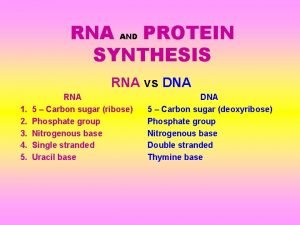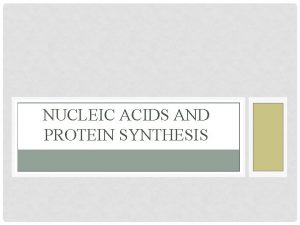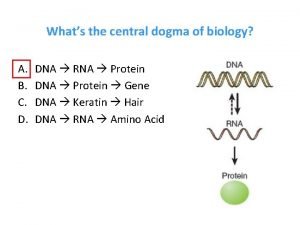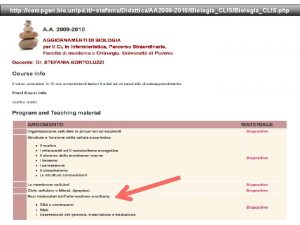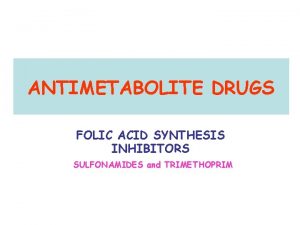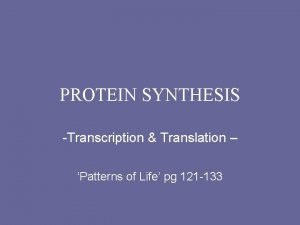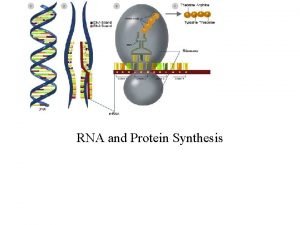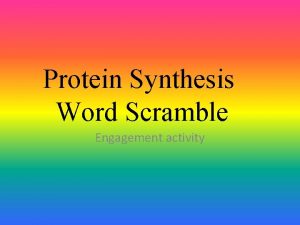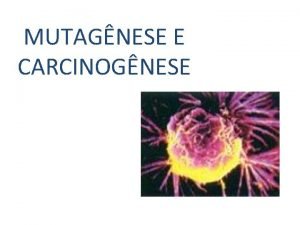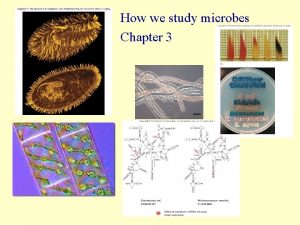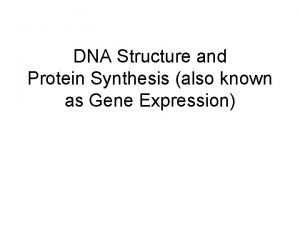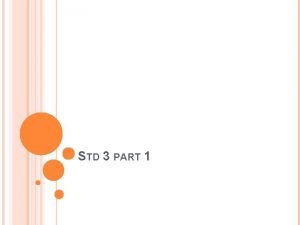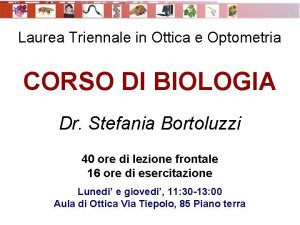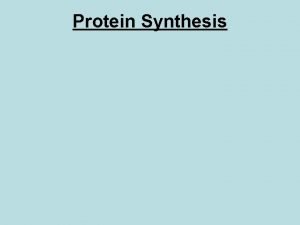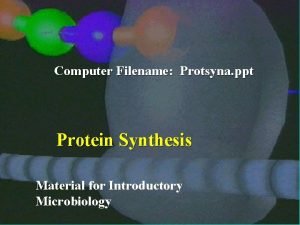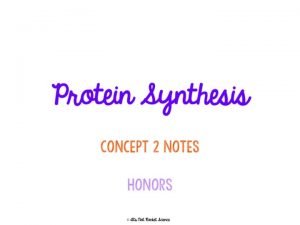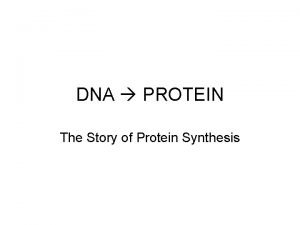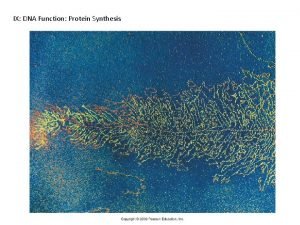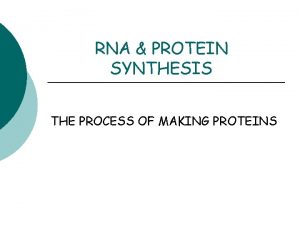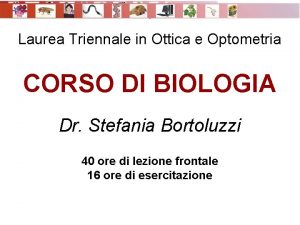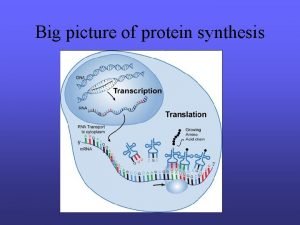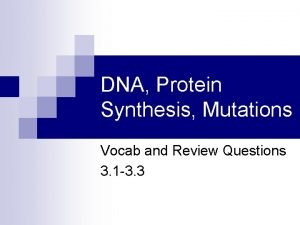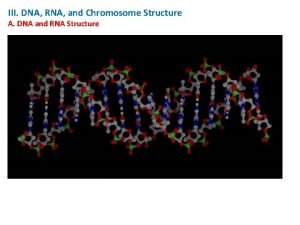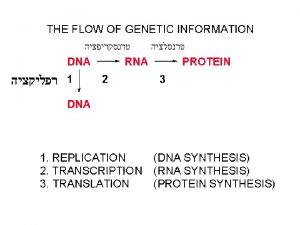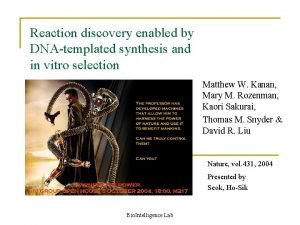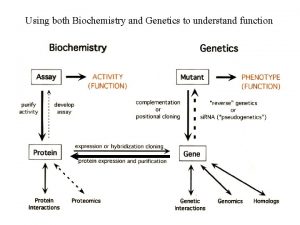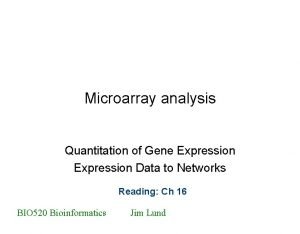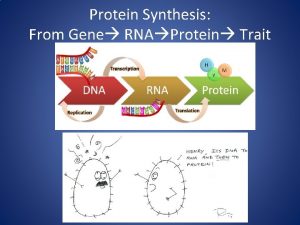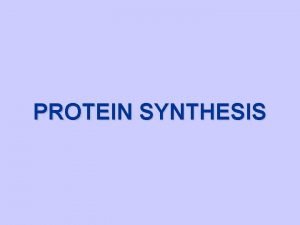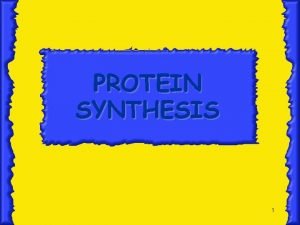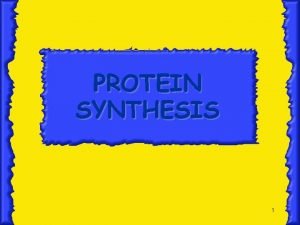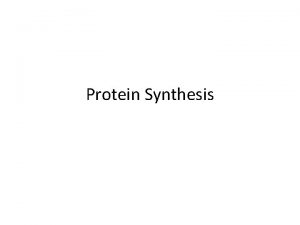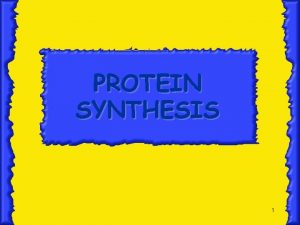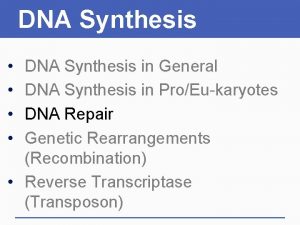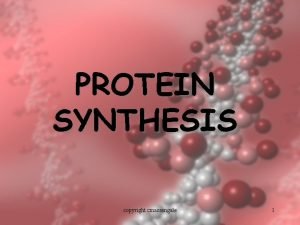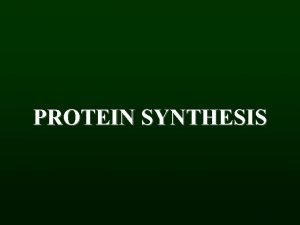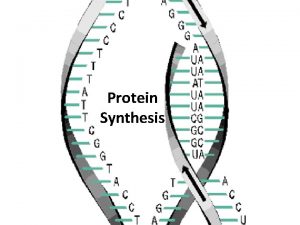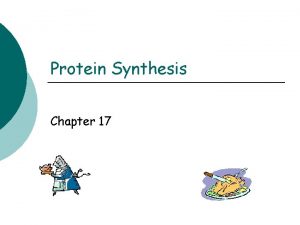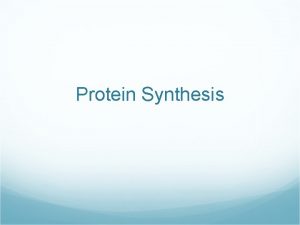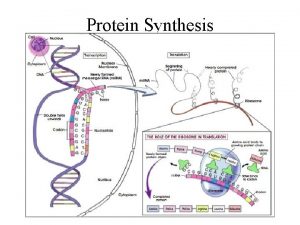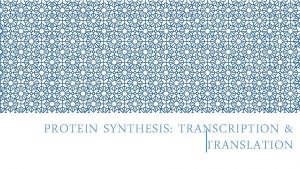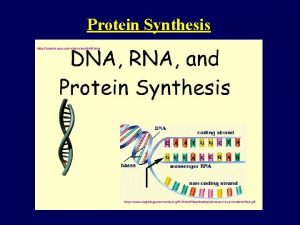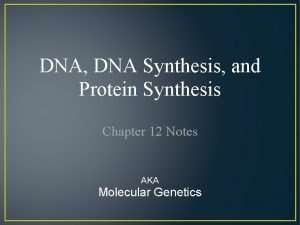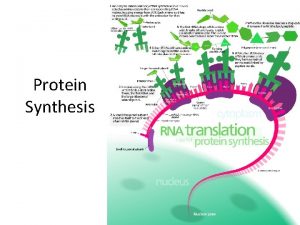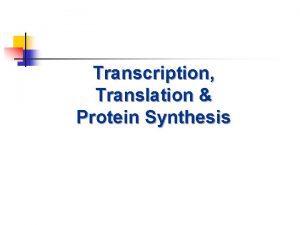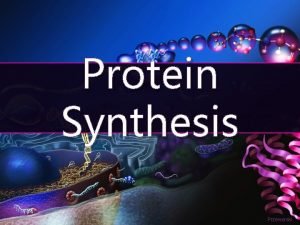DNA Protein Synthesis What is DNA DNA is















































- Slides: 47

DNA & Protein Synthesis

What is DNA? � DNA is a type of organic compound called a nucleic acid � There are only two types of nucleic acids discovered so far: DNA and RNA � DNA stands for Deoxyribo. Nucleic Acid

Interesting DNA Facts � DNA is really long! The total length of DNA present in one adult human is the equivalent distance from the earth to the sun and back. This equals approximately 299, 195, 741, 400 meters (185, 911, 614 miles)

Interesting DNA Facts How does it fit in our bodies? By packing itself very tightly using coils of DNA to form chromatin and chromosomes.

DNA Components DNA is made of long chains of nucleotides �each nucleotide has 3 parts: 1. deoxyribose sugar 2. phosphate group 3. nitrogenous base

DNA Components there are 4 possible nitrogen bases: �the purines: Adenine and Guanine �the pyrimidines: Cytosine and Thymine

DNA Structure �the nucleotides combine by dehydration to form 2 long chains held together by covalent bonds

DNA Structure �the 2 chains are joined together by hydrogen bonds between the bases

DNA Structure �the 2 bases that are bonded are called a base pair �Base Pairing Rules: A pairs with T and G pairs with C

DNA Structure Chargaff’s rule states that the DNA of any organism must contain equal amounts of A&T and C&G Ex: If a strand of DNA is 15% G, how much of the DNA is made of A, C, and T? 15% G = 15% C total 30% 70% left A & T = 35% each

DNA Structure Watson & Crick determined the shape of the DNA molecule was a twisted ladder, or a double helix

R. Franklin • Rosalind Franklin (1950’s): studied DNA using a technique called x-ray diffraction. • Her work was key to Watson & Cricks work

DNA Structure �The sides of the ladder are made of sugars and phosphates, and are held together by covalent bonds �The rungs of the ladder are made of nitrogen base pairs, and contain hydrogen bonds

DNA Replication

DNA Replication The copying of a DNA strand is called replication When does copying of DNA occur? Before cell division (S phase of interphase)

DNA Replication There are multiple enzymes responsible for replication: 1. Helicase – breaks the hydrogen bonds between the 2 nucleotide strands this uncoils & unzips the DNA each strand is now a template

DNA Replication

DNA Replication 2. DNA Polymerase helps free nucleotide bases pair to the original strands

DNA Replication 3. DNA Ligase “glues” the new nucleotide strands together

DNA Replication Example problem: Write the complementary strand produced by replication of the following DNA strand. AATGCTAGCCGT TTACGATCGGCA

DNA Replication Each new DNA molecule is made of one old side and one new side this is called semiconservative replication the 2 new DNA molecules are identical

Comparing DNA & RNA DNA � 2 strands �Deoxyribose sugar �N bases: A, G, C, T

Comparing DNA & RNA (ribonucleic acid) � 1 strand �Ribose sugar �N bases: A, G, C, U (Uracil)

Transcription

Transcription �Transcription is the process of making an RNA copy of a portion of DNA Why does the cell need to transcribe the DNA? the DNA cannot leave the nucleus

Transcription The steps for transcription are similar to replication: 1. RNA polymerase uncoils & unzips a portion of DNA 2. RNA nucleotides pair with one of the DNA strands

Transcription 3. A single strand of messenger RNA is produced

Transcription 4. 5. The m. RNA carries the copied information to the ribosome out in the cytoplasm Ribosomes are made up of proteins and ribosomal RNA or r. RNA

Transcription Example problem: Write the m. RNA strand produced by the transcription of the following DNA strand. AATGCTAGCCGT UUACGAUCGGCA

Genetic Code The genetic code is the sequence of nitrogen bases along one strand of DNA �The sequence determines how proteins are made �Proteins are long chains of amino acids

Genetic Code �There are 20 different amino acids

Genetic Code �A sequence of 3 bases provides the code for an amino acid and is called a codon 64 codons are in the genetic code: 61 are amino acids 3 are stop codons


Genetic Code �There can be more than one codon for an amino acid �The genetic code is universal because the codons represent the same amino acids in ALL organisms

Protein Synthesis

Protein Synthesis Two Stages of Protein Synthesis: 1. Transcription (DNA RNA) 2. Translation (RNA amino acids)

Translation is the process that converts m. RNA into a sequence of amino acids �Transfer RNA (t. RNA) brings amino acids from the cytoplasm to the ribosome

Translation Steps to Translation: 1. The start codon of the m. RNA attaches to the ribosome 2. A t. RNA molecule brings a specific amino acid 3. The t. RNA anticodon pairs with the m. RNA codon

Translation 4. The m. RNA slides along the ribosome, forming a polypeptide chain 5. Translation ends with a stop codon on the m. RNA

The Big Picture

Mutations

Gene Mutations are permanent changes in the DNA sequence 1. A point mutation is a change in a single base pair This may or may not affect the protein

Gene Mutations 2. A frameshift mutation occurs when a single base is added or deleted from DNA Every codon after the mutation is different

Gene Mutations � What’s worse? the difference to your cell? Which is Point Mutation � GCATTG GCAATG � MY DOG SKIP ME DOG SKIP Frameshift Mutation � GATTACAGC… GTTACAGCA… � MY DOG SKIP MD OGS KIP

Causes of Mutations Mutagens are any agents that cause a change in the DNA sequence. �If a single body cell is mutated, this can result in cancer �If a reproductive cell is mutated, this can result in a “mutated” offspring (having a new physical trait)

Causes of Mutations Spontaneous mutations: mistakes that occur during replication

Causes of Mutations Environmental Agents: exposure to radiation (X-rays, gamma rays, UV rays) or certain chemicals
 Dna and genes chapter 11
Dna and genes chapter 11 Dna protein synthesis study guide answers
Dna protein synthesis study guide answers Protein synthesis
Protein synthesis Ribonucleotide vs deoxyribonucleotide
Ribonucleotide vs deoxyribonucleotide Ribonucleic acid
Ribonucleic acid Protein synthesis
Protein synthesis Section 12-3 rna and protein synthesis answer key
Section 12-3 rna and protein synthesis answer key Protein synthesis
Protein synthesis Methoteraxate
Methoteraxate Protein synthesis and mutations
Protein synthesis and mutations Protein synthesis animation mcgraw hill
Protein synthesis animation mcgraw hill Transcription and translation bbc bitesize
Transcription and translation bbc bitesize Section 12 3 rna and protein synthesis
Section 12 3 rna and protein synthesis Protein synthesis scramble
Protein synthesis scramble Teste de ames
Teste de ames Protein synthesis
Protein synthesis Transfer rna
Transfer rna Order of bases in dna
Order of bases in dna Protein synthesis
Protein synthesis Which best summarizes the process of protein synthesis?
Which best summarizes the process of protein synthesis? Parent genotype
Parent genotype Missense mutation in sickle cell anemia
Missense mutation in sickle cell anemia Protein synthesis
Protein synthesis Fictional character μετάφραση
Fictional character μετάφραση Protein synthesis ppt
Protein synthesis ppt Protein synthesis
Protein synthesis Synthesis
Synthesis Protein synthesis restaurant analogy
Protein synthesis restaurant analogy Protein synthesis
Protein synthesis Concept map of protein synthesis
Concept map of protein synthesis Translate
Translate Dna cookbook analogy
Dna cookbook analogy Totipotent cells
Totipotent cells Protein synthesis
Protein synthesis Picture transcription
Picture transcription Protein synthesis
Protein synthesis Protein synthesis and mutations
Protein synthesis and mutations Protein synthesis splicing
Protein synthesis splicing Translation and transcription venn diagram
Translation and transcription venn diagram Channel vs carrier proteins
Channel vs carrier proteins Protein-protein docking
Protein-protein docking Bioflix activity dna replication dna replication diagram
Bioflix activity dna replication dna replication diagram Dehydration synthesis dna
Dehydration synthesis dna Telomerase
Telomerase Dna-templated synthesis
Dna-templated synthesis Dna synthesis at replication fork
Dna synthesis at replication fork Dna rna protein
Dna rna protein Protein
Protein


